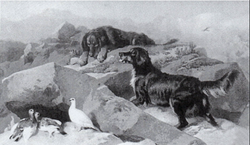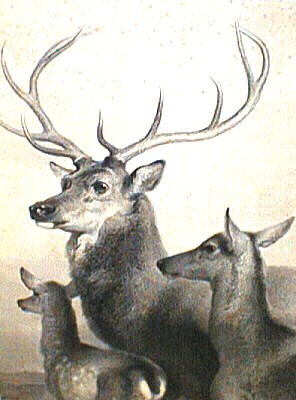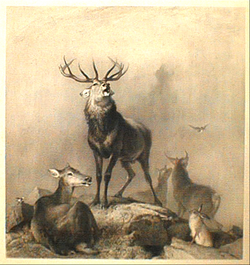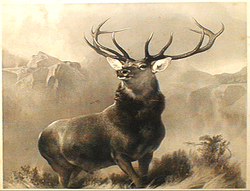Sir Edwin Henry Landseer and Thomas Landseer
|
Research by Sue Cannon
|
SIR EDWIN HENRY LANDSEER (1802–1873), animal-painter, third and youngest son of John Landseer, was born at 33 Foley Street (then 71 Queen Anne Street East), London on 7 March 1802. Edwin was a child prodigy, in that his drawing and observational skills were highly developed at a young age. In 1813, at the age of eleven, he was awarded the silver palette of the Society of Arts for his drawing of animals. There are some very accomplished nature drawings, completed when he was five, in the Victoria and Albert Museum (previously the South Kensington Museum) and other Galleries.
In 1826 Landseer exhibited a large picture of The Chase - now the property of the Duke of Bedford - at the Royal Academy. The same year he was elected an associate of the Royal Academy; at twenty-four this was the earliest age permitted by the rules. In 1831 he was elected to the full honours of the Academy and exhibited the two small but celebrated pictures, High Life and Low Life at the British Institution (now in the National Gallery), in which he contrasted opposite classes of society as reflected in their dogs - the aristocratic deerhound and the butcher's mongrel. In 1833 this vein of humour was developed in his Jack in Office (South Kensington Museum). They were the first of those canine burlesques of human life to which he owed much of his popularity. (1)
Estelle Hurll (1863–1924) wrote in her biography of Edwin Landseer, 'He looked upon most animals with the eyes of the artist, the poet and natural historian, but the dog alone he painted as a friend'. This aptly sums up how his art was perceived at the time. (2) Keri Cronin sums up today’s attitude to Edwin’s works when she writes, 'Looking at The Old Shepherd’s Chief Mourner I feel strongly connected to the reformers and advocates from previous generations who understood the impact that art and visual culture could have in the very complex discussions about the ways in which non-human animals should be treated in our society, people who have paved the way for activists today. This painting, and indeed most of Landseer’s other paintings are not taken that seriously by art historians and critics today. As the V&A gallery label indicates, this image is often read as an example of Victorian sentimentality, a throwback to “olden days” when life was somehow different from ours. However, it is important to take another look at this painting, to remember the place this image held in the minds of those involved with early animal advocacy campaigns. As is the case today, those wanting to change the world for animals relied heavily on visual imagery, and Landseer’s work was especially popular in this context. This image may have more in common with our current activist efforts than we recognize at first glance'. (3)
Adding to Edwin’s fame were the engraved etchings made of his paintings and sold to the public by a print publisher who owned the rights to the image. There were several price ranges for the different states of the print. For example, in 1845 Thomas Agnew and Sons sold first class proofs for £10.10s, second class proofs for £7.7s, and 'Common Prints' at £4.4s. The reproductive print witnessed its golden age, in terms of quantity, between 1830 and 1880. (4)
In 1826 Landseer exhibited a large picture of The Chase - now the property of the Duke of Bedford - at the Royal Academy. The same year he was elected an associate of the Royal Academy; at twenty-four this was the earliest age permitted by the rules. In 1831 he was elected to the full honours of the Academy and exhibited the two small but celebrated pictures, High Life and Low Life at the British Institution (now in the National Gallery), in which he contrasted opposite classes of society as reflected in their dogs - the aristocratic deerhound and the butcher's mongrel. In 1833 this vein of humour was developed in his Jack in Office (South Kensington Museum). They were the first of those canine burlesques of human life to which he owed much of his popularity. (1)
Estelle Hurll (1863–1924) wrote in her biography of Edwin Landseer, 'He looked upon most animals with the eyes of the artist, the poet and natural historian, but the dog alone he painted as a friend'. This aptly sums up how his art was perceived at the time. (2) Keri Cronin sums up today’s attitude to Edwin’s works when she writes, 'Looking at The Old Shepherd’s Chief Mourner I feel strongly connected to the reformers and advocates from previous generations who understood the impact that art and visual culture could have in the very complex discussions about the ways in which non-human animals should be treated in our society, people who have paved the way for activists today. This painting, and indeed most of Landseer’s other paintings are not taken that seriously by art historians and critics today. As the V&A gallery label indicates, this image is often read as an example of Victorian sentimentality, a throwback to “olden days” when life was somehow different from ours. However, it is important to take another look at this painting, to remember the place this image held in the minds of those involved with early animal advocacy campaigns. As is the case today, those wanting to change the world for animals relied heavily on visual imagery, and Landseer’s work was especially popular in this context. This image may have more in common with our current activist efforts than we recognize at first glance'. (3)
Adding to Edwin’s fame were the engraved etchings made of his paintings and sold to the public by a print publisher who owned the rights to the image. There were several price ranges for the different states of the print. For example, in 1845 Thomas Agnew and Sons sold first class proofs for £10.10s, second class proofs for £7.7s, and 'Common Prints' at £4.4s. The reproductive print witnessed its golden age, in terms of quantity, between 1830 and 1880. (4)

The Ptarmigan Hill
Acc No unknown Edwin Henry Landseer 1802-1873 (after) Thomas Landseer 1795–1880 (engraver) engraving Size: 52.1 x 88 cm (20.5 x 34.6 in) Braemar, Monarch of the Glen and The Ptarmigan Hill were all donated by Emma Walmsley, 1879-1945 373 Clifton Drive North, Lytham St Annes 27 September 1943 Also in the Collection: Jacquard Tapestry Acc No 65 Return of the Hunters, Bolton Wood after Sir Edwin Henry Landseer donated by Miss Margaret Burdekin (1868-1944) or Miss Elizabeth Burdekin (1869-1958), 28 July 1941 |

Stag and Deer
(A Deer Family) Acc No 110 Edwin Henry Landseer 1802-1873 (after) Thomas Landseer 1795-1880 (engraver) engraving (probably 1872) Size: 68.6 x 50.8 cm (27 x 20 in) published 1 Jan 1873 by Thomas Agnew & Sons, 5 Waterloo Place, London donated by Eva Dickinson nee Walmsley 1886-1949 Balmoral Road, Lytham St Annes 18 March 1946 |
THOMAS LANDSEER (1795-1880), Edwin’s eldest brother, was a talented engraver. Thomas collaborated with Edwin from childhood, as the younger brother preferred drawing and painting. He would go on to dedicate much of his career to engraving his brother's most famous paintings. In total Thomas copied over 125 of Edwin's works.
Having studied under Benjamin Robert Haydon, Thomas Landseer also produced many original etchings of his own work. In 1828 he created a book parodying human folly, 'Monkeyana or Men in Miniature'. He also published 'Characteristic Sketches of Animals' in 1832 and 'The Natural History of Birds' in 1836. Thomas was elected an Associate of the Royal Academy (ARA) in 1868. He died in London in 1880.
Other well-known engravers of Edwin’s paintings were Charles George Lewis, Samuel Cousins, Charles Mottram, John Outrim, B P Gibbon,
T L Atkinson, H T Ryall, W H Simmons, Robert Graves ARA, W T Davey and R J Lane ARA (lithographs).
The Monarch of the Glen is one of the most famous images painted by Edwin Landseer, who is also known for his Lion Sculptures in London's Trafalgar Square. First exhibited in 1851, the work was originally painted for the refreshment-room at the House of Lords, but the House of Commons declined to pay for it. 'The Stag' painting and prints have historically become synonymous with Scotland, so much so that the image was used to promote Dewar’s Scotch Whiskey as The Monarch Of The Glen in 1925. (4) The large fortune left by Sir Edwin was mostly accumulated from the sale of the copyrights of his pictures for engravings.
At a sale in 1881, the high price of £5,250 was paid for a large cartoon in coloured chalks of Stag and Deerhound. The Monarch of the Glen was sold in April 1892 for over £7,000. Due to the generosity of private persons, principally Mr Vernon, Mr Sheepshank and Mr Jacob Bell, the nation is rich in Landseer's works; they can be found at the Victoria and Albert Museum, The National Gallery and The British Museum, which contains a collection of his etchings and sketches.
Having studied under Benjamin Robert Haydon, Thomas Landseer also produced many original etchings of his own work. In 1828 he created a book parodying human folly, 'Monkeyana or Men in Miniature'. He also published 'Characteristic Sketches of Animals' in 1832 and 'The Natural History of Birds' in 1836. Thomas was elected an Associate of the Royal Academy (ARA) in 1868. He died in London in 1880.
Other well-known engravers of Edwin’s paintings were Charles George Lewis, Samuel Cousins, Charles Mottram, John Outrim, B P Gibbon,
T L Atkinson, H T Ryall, W H Simmons, Robert Graves ARA, W T Davey and R J Lane ARA (lithographs).
The Monarch of the Glen is one of the most famous images painted by Edwin Landseer, who is also known for his Lion Sculptures in London's Trafalgar Square. First exhibited in 1851, the work was originally painted for the refreshment-room at the House of Lords, but the House of Commons declined to pay for it. 'The Stag' painting and prints have historically become synonymous with Scotland, so much so that the image was used to promote Dewar’s Scotch Whiskey as The Monarch Of The Glen in 1925. (4) The large fortune left by Sir Edwin was mostly accumulated from the sale of the copyrights of his pictures for engravings.
At a sale in 1881, the high price of £5,250 was paid for a large cartoon in coloured chalks of Stag and Deerhound. The Monarch of the Glen was sold in April 1892 for over £7,000. Due to the generosity of private persons, principally Mr Vernon, Mr Sheepshank and Mr Jacob Bell, the nation is rich in Landseer's works; they can be found at the Victoria and Albert Museum, The National Gallery and The British Museum, which contains a collection of his etchings and sketches.
REFERENCES
(1) https://en.wikisource.org/wiki/Landseer,_Edwin_Henry_(DNB00)
(2) Animal Welfare and Human Values By Rod Preece and Lorna Chamberlain. Wilfred Laurier University Press 1993.
(3) http://www.ourhenhouse.org/2013/07/more-than-a-painting-the-old-shepherds-chief-mourner-and-the-seeds-of-early-animal-advocacy/
(4) https://www.academia.edu/6194471/Art_Dealing_in_Nineteenth-Century_England_The_Case_of_Thomas_Agnew
(5) http://www.wildlifeart.org/collection/artists/artist-thomas-landseer-454/
(6) http://www.amazon.com/Original-Antique-Victorian-Advertisement-Landseer/dp/B005SOO03G
(1) https://en.wikisource.org/wiki/Landseer,_Edwin_Henry_(DNB00)
(2) Animal Welfare and Human Values By Rod Preece and Lorna Chamberlain. Wilfred Laurier University Press 1993.
(3) http://www.ourhenhouse.org/2013/07/more-than-a-painting-the-old-shepherds-chief-mourner-and-the-seeds-of-early-animal-advocacy/
(4) https://www.academia.edu/6194471/Art_Dealing_in_Nineteenth-Century_England_The_Case_of_Thomas_Agnew
(5) http://www.wildlifeart.org/collection/artists/artist-thomas-landseer-454/
(6) http://www.amazon.com/Original-Antique-Victorian-Advertisement-Landseer/dp/B005SOO03G


